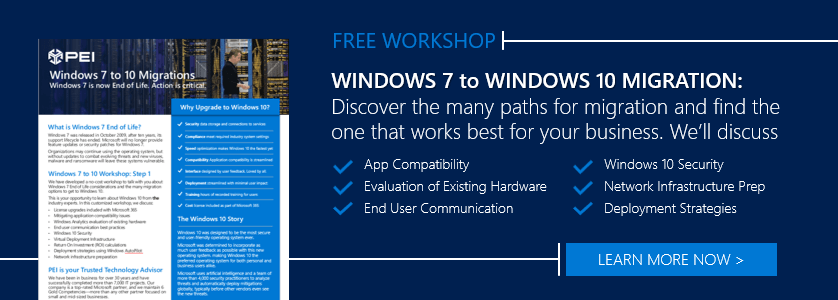Complete Webinar Transcript: Windows 7 End of Life Common Questions and Concerns
Introduction:
Adam: Thanks for joining our webinar today. My name is Adam Lee from PEI, a Microsoft Gold Partner servicing customers throughout the United States. This is one of a series of short webinars we are recording on a variety of topics surrounded by buzz around. Today we will be discussing Windows 7 going End of Life on January 14, 2020, and what this means for organizations. We will also talk about Windows 10, migration projects, and things to consider based on our experience.
To help talk more about Windows 7, we thought it’d be best to team up with Microsoft to address major questions we’re hearing from our clients. PEI works hand-in-hand with Microsoft on many major projects to ensure we are providing the right solution for our customers’ needs. We’ve got Kevin Martins here with us today. Kevin is a Partner Technical Architect in the Modern Workplace space at Microsoft. Kevin, thank you for being here today.
Kevin: Thank you for having me on today.
Question 1: What Does End of Life for Windows 7 Really Mean?
Adam: So Kevin, Windows 7 has been around for ages and is now going End of Life. What does all of this really mean?
Kevin: Great question. Windows 7 was launched in late October 2009 in its General Availability format. This version of Windows was launched to replace Windows Vista and quickly outgrew the number of Vista deployments. Within 2.5 years of its original release, Windows 7 grew to more than 630 million systems worldwide. That type of deployment speaks volumes to how well it was received and used by so many people and organizations.
The important point here is that it was released over ten years ago. It was built during a time where computer viruses were not nearly as widespread or sophisticated or polymorphic (constantly changing) as they are today. As with most major systems and applications, Microsoft releases, Windows 7 had a ten-year support cycle where Microsoft provided updates and security patches for it. This support cycle is now ending as Windows 7 has reached its End of Life status on January 14, 2020.


